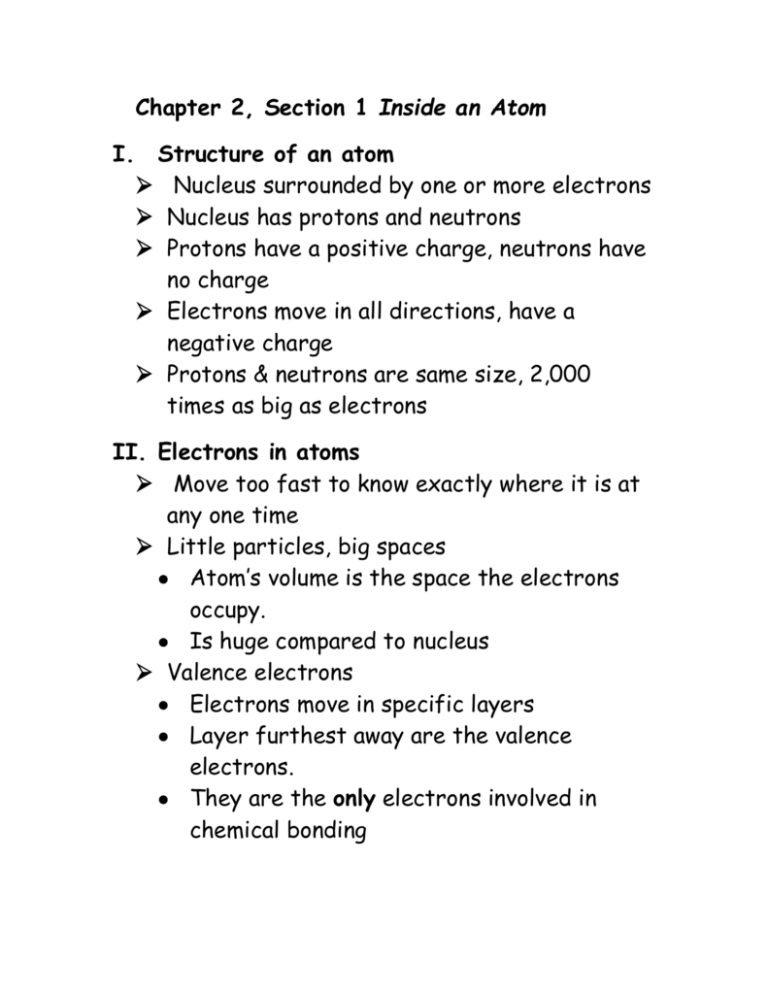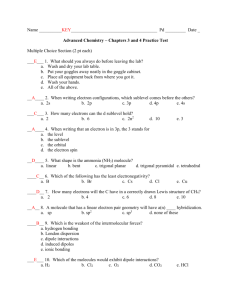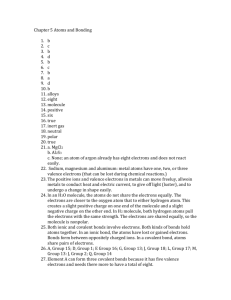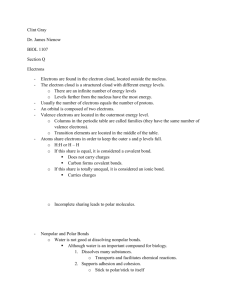Chapter 2, Section 1 Inside an Atom
advertisement

Chapter 2, Section 1 Inside an Atom I. Structure of an atom Nucleus surrounded by one or more electrons Nucleus has protons and neutrons Protons have a positive charge, neutrons have no charge Electrons move in all directions, have a negative charge Protons & neutrons are same size, 2,000 times as big as electrons II. Electrons in atoms Move too fast to know exactly where it is at any one time Little particles, big spaces Atom’s volume is the space the electrons occupy. Is huge compared to nucleus Valence electrons Electrons move in specific layers Layer furthest away are the valence electrons. They are the only electrons involved in chemical bonding Electron dot diagram shows the valence electrons III. Why atoms form bonds Neutral atom never has more than 8 valence electrons. Atoms with either 8 or 0 valence electrons are less reactive (or more stable) than they were before A chemical bond forms when valence electrons move between 2 atoms. They may be transferred or shared Chapter 2, Section 2 Atoms in the Periodic Table IV. Organizing the elements Organization is based on how elements react Atomic number is number of protons in nucleus Table organizes so number of protons increases left to right, top to bottom Columns are called groups of families Rows are called periods Valence electrons increase across a period V. Comparing families of elements Noble gases Group 18 elements all have 8 valence electrons (except helium) They are inert, meaning inactive, so do not react easily Reactive nonmetals Group 17 (called Halogen family) elements are very reactive. They are close to a full valence shell, so they readily grab any available electron Reactive metals Group 1 (called alkali metals) also very reactive. With 1 valence electron, they donate it freely Chapter 2, Section 3 Ionic Bonds VI. Electron Transfer An ion is an atom that has become electrically charged, by gaining or giving up an electron. VII. Forming an ionic bond Positive and negative charges attract each other, so positive and negative ions will form a bond. Salt is an example. Sodium (Na) gives up an electron, so is a positive ion. Chlorine (Cl) takes the electron, so it is a negative ion. The opposites then bond to each other VIII. Polyatomic ions A compound can be an ion. The carbonate ion is CO32-. It is commonly found in calcium carbonate, which is found in Tums and other antacids IX. Naming ionic compounds Positive ion is first, and is usually the name of the elements Negative ion adds –ide to name of element. X. Properties of ionic compounds Crystal shape Ions form orderly arrangements, which are crystals. Positive ions want to be as far away as possible from other positives and as close as possible to negatives. High melting points All ionic compounds are solid at room temperature Multiple bonds in crystal structure are hard to break, so do not melt easily Electrical conductivity When dissolved in water (or melted), ionic compounds freely conduct electricity. Electrons are free to move. Not true in a solid, where electrons are tightly held in place. Chapter 2, Section 4 Covalent Bonds XI. Electron sharing Instead of taking/getting an electron, atoms may share an electron or two. The shared electron forms a covalent bond XII. How many bonds? Will form bonds to bring number of valence electrons up to 8 Example, oxygen has 6 valence electrons, so it forms 2 bonds with hydrogen, to bring total to 8 Sometimes get double bonds, where the atoms share 2 or 3 pairs of electrons XIII. Properties of molecular bonds Covalent bonds form molecular compounds Melting and boiling points are much lower than ionic compounds. Bonds between the atoms are stronger, but bonds between molecules are weaker. Poor conductors of electricity Water does not conduct electricity, so why worry about hair dryer in bathtub? XIV. Unequal sharing of electrons If one pulls much more strongly, electron spends more time there, giving a slight negative charge to that side of the bond or molecule. That is called “polar” Difference between polar bonds and polar molecules. May have polar bonds lined up to cancel each other out, and get a nonpolar molecule Nonpolar molecules Atoms pull equally strongly on electrons so they stay balanced, with no charges, or polar bonds cancel out Polar molecules Water is polar because the polar bonds do not cancel each other out XV. Attractions between molecules Water molecules are attracted to each other, positive pole to negative pole That is why water has surface tension Carbon dioxide molecules are not, because they are nonpolar Oil and water don’t mix because one is polar and the other nonpolar. Soap has a polar end and a nonpolar end





